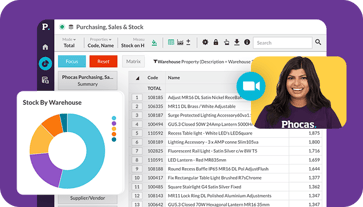
Find out how our platform gives you the visibility you need to get more done.
Get your demo todayWhat is generative business intelligence?
Generative business intelligence (Gen BI) is the combination of generative AI and Large Language Models (LLMs) with traditional Business intelligence functions to create AI-driven decision making workflows for organizations.
How does generative business intelligence (Gen BI) differ from traditional business intelligence?
Business Intelligence (BI) is the process of collecting unstructured data from business systems and software and analysing and present this information to business users in formats that help them understand their work and make data-driven decisions.
Generative business intelligence (Gen BI) differs because it uses generative AI to automate and enhance data analysis. Instead of just analyzing past data, Gen BI can generate new projections like forecasts as well as suggest new data visualizations or actionable insights based on natural language queries.
What is a typical use case of generative business intelligence?
While there are many use cases for generative business intelligence, typically we see Phocas customers initially ask for their complex data from many data sources to be consolidated. This allows manufacturers, wholesalers and retailers to have real-time data access without the need for data analysts so everyone can make informed decisions about sales, pricing, purchasing and performance.
How does BI software improve business performance?
As the speed of business continues to increase, the willingness to embrace business intelligence will make or break companies in the years to come.
BI enhances the ability to lead teams and internal analytical capabilities and eliminates the “gut-feel” approach to decision making. When your data is organized into one view of the truth, it can be used to uncover new opportunities, evaluate outcomes, and predict future trends. As you empower your team with fact-based insights, they can do more to move the business forward, plan and predict performance improvement and outcomes, improve customer loyalty and continually create competitive advantages.
What’s the difference between BI solutions and BI systems?
A BI System is the underlying technology infrastructure (databases, ETL processes, data warehouses) that enables business intelligence. A BI solution uses that system, along with specific tools like dashboards and reporting software to solve business problems and deliver insights. A BI system is a core component within a BI solution.
What is a large language model (LLM)?
A large language model (LLM) is a type of AI model specifically designed to understand, generate and manipulate human language. It's trained on vast amounts of text data.
How does natural language processing improve generative AI?
GenAI leverages natural language by using LLMs to process, understand the intent and context of human language queries, and then generate human-like text, summaries or answers in response. This natural language processing remove the need for data scientists and analysts to use SQL and domain specific technical expertise and to dig into business data.
What role do large language models (LLMs) play in generative BI?
LLMs play an important role in generative BI by enabling users to interact with data using natural language and chatbots. They translate these queries into clear answers, interpret metrics and provide easy-to-understand narratives, insights and visualizations.
Is generative business intelligence the same as predictive analytics?
Yes, gen BI and predictive analytics overlap - they both use historical datasets, statistical algorithms and machine learning techniques to make predictions about future outcomes. Gen BI applies generalised LLMs to the same processes in a way that makes it more accessible to more people across the business.
Does generative BI help make data analytics more self-service?
Yes generative BI helps make data analytics more self-service. It allows non-technical users to ask complex questions in natural language/plain language and receive insights reducing the need to ask people for help. Gen BI tools like Phocas AI also provides the steps it takes to arrive at the answer so helps new users learn as they go.
Do all BI tools have artificial intelligence?
No not all BI tools have artificial intelligence. While AI capabilities are increasingly common, traditional BI tools may focus more on data reporting, sql querying and basic visualizations without advanced AI or ML features.
Examples of software providers that offer generative business intelligence
software providers that offer Generative Business Intelligence include:
- Phocas (LLM embedded in Phocas Analytics)
- Amazon QuickSight or Amazon Q(AWS)
- Microsoft Power BI (with features like Q&A and Copilot)
- Tableau (with features like Tableau GPT)
- Qlik (with its Insight Advisor)
Does gen BI improve dashboards?
Yes, Gen BI streamlines dashboard creations. It can automate the process by suggesting relevant charts based on the data, generating real-time summaries for dashboards, and allowing users to create or modify visualizations through natural language commands.
Understand the past, operate better today, and plan well for the future
